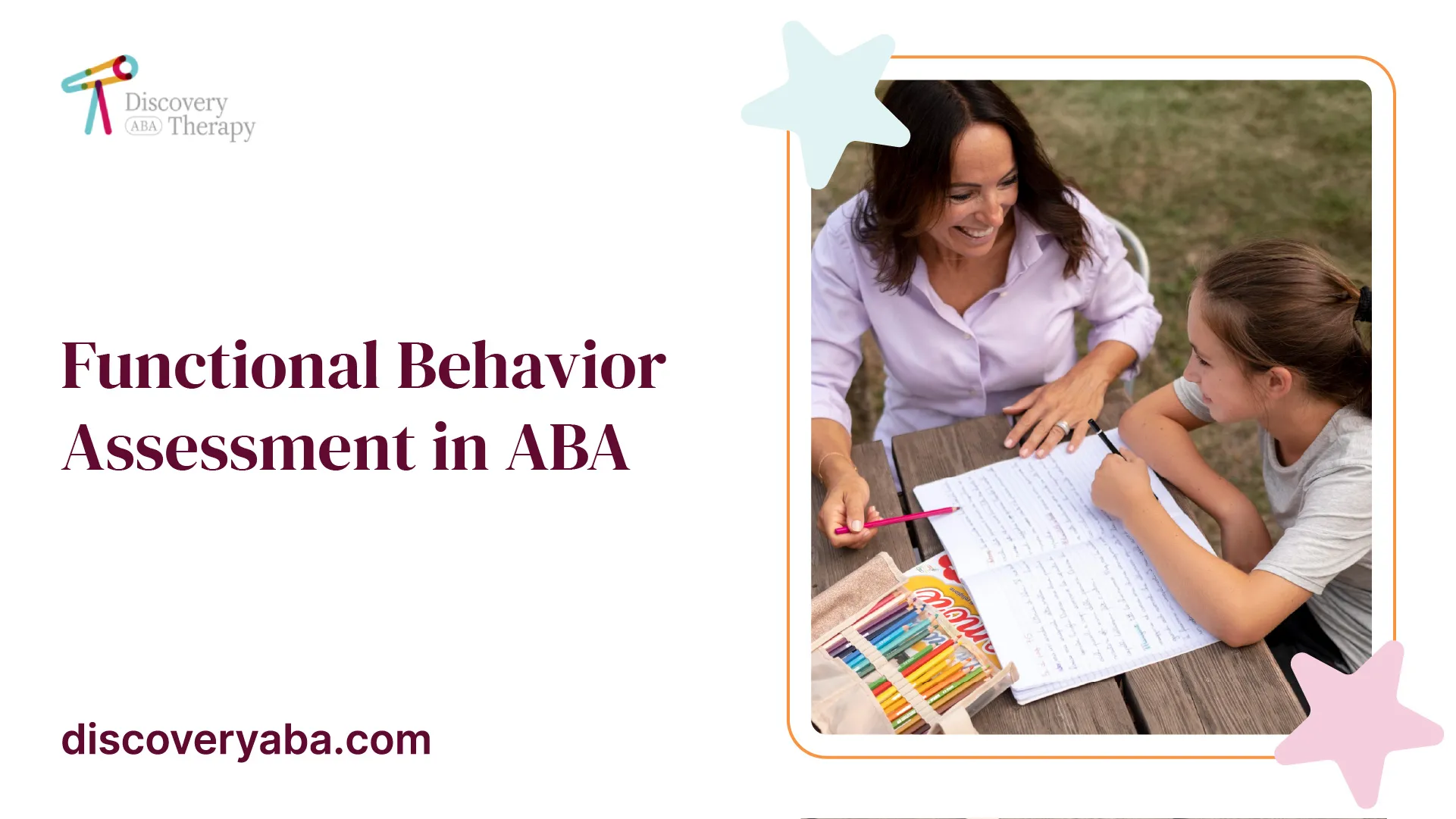Functional Behavior Assessment in ABA
Unlock effective intervention strategies with functional behavior assessment in ABA. Gain insights into behavior functions and implement tailored plans.

Understanding Behavior Assessment
When it comes to addressing challenging behaviors, understanding the underlying causes is crucial. This is where a Functional Behavior Assessment (FBA) comes into play. An FBA is a systematic process that involves gathering and analyzing data to determine the function or purpose of a specific behavior, providing valuable insights into the underlying causes of challenging behaviors.
Importance of Functional Assessments
Functional behavior assessments play a vital role in applied behavior analysis (ABA) and other fields working with individuals who exhibit challenging behaviors. By identifying the function behind a behavior, professionals can develop effective behavior intervention plans tailored to the individual's needs. This approach allows for a more targeted and efficient intervention, leading to improved outcomes and increased quality of life.
Functional assessments are particularly valuable in the context of autism spectrum disorder (ASD), as they help professionals better understand the reasons behind behaviors exhibited by individuals with ASD. By identifying the function of a behavior, interventions can be designed to address the underlying motivation, encouraging positive behaviors and reducing challenging ones.

Process of Conducting an Assessment
Conducting a functional behavior assessment involves several essential steps to gather relevant data and analyze behavior patterns. The process typically includes the following:
- Defining the behavior: Clearly defining the target behavior is the first step in conducting a functional behavior assessment. This involves describing the behavior in observable and measurable terms. A well-defined behavior allows for accurate data collection and analysis.
- Data collection methods: Various data collection methods are employed to gather information about the behavior. These may include direct observation, interviews with key individuals (such as parents, teachers, or caregivers), and the use of behavior assessment tools or questionnaires. The goal is to collect comprehensive and objective data to understand the behavior's context and triggers.
- Gathering baseline data: Before implementing any interventions, it is essential to establish a baseline by observing the behavior in its natural environment. Baseline data provides a comparison point to assess the effectiveness of intervention strategies.
- Developing behavior hypotheses: Based on the data collected, behavior analysts develop hypotheses about the function or purpose of the behavior. These hypotheses serve as working theories that guide the selection of appropriate interventions.
- Testing the hypothesis: Once the behavior hypotheses are formed, behavior analysts conduct experiments or functional analysis to test the validity of their hypotheses. This may involve manipulating variables or implementing interventions to observe the impact on the behavior.
- Analyzing data and developing an intervention plan: The data collected throughout the assessment process is analyzed to refine the behavior hypotheses and develop an individualized behavior intervention plan. This plan outlines specific strategies and techniques to address the challenging behavior effectively.
By following this systematic process, behavior analysts and professionals can gain valuable insights into the underlying causes of challenging behaviors and develop effective intervention plans tailored to the individual's needs. Collaboration between professionals, educators, and parents is essential to ensure consistency and continuity in addressing challenging behaviors.
Conducting Functional Behavior Assessments
To effectively address challenging behaviors and develop targeted intervention strategies, behavior analysts rely on conducting functional behavior assessments. This process involves collecting data and developing behavior hypotheses to gain insights into the function of the behavior.
Data Collection Methods
Collecting accurate and comprehensive data is an essential component of a functional behavior assessment. This data provides valuable information about the antecedents, behaviors, and consequences associated with the behavior of interest. Common methods used for data collection include:
- Direct Observation: Direct observation involves systematically recording the occurrence and characteristics of the behavior in its natural environment. Observers use predetermined behavior definitions and data collection tools to ensure consistency and reliability.
- Interviews: Interviews with individuals who interact with the person exhibiting the behavior, such as caregivers, teachers, or therapists, can provide valuable insights. Structured interviews or questionnaires help gather information about the circumstances surrounding the behavior, potential triggers, and consequences.
- Checklists and Rating Scales: Checklists and rating scales provide a standardized way to collect data on specific behavior dimensions. They allow observers to rate the frequency, intensity, or duration of the behavior, providing quantitative data for analysis.
By employing multiple data collection methods, behavior analysts can obtain a comprehensive understanding of the behavior in different contexts and settings. This information serves as the foundation for developing behavior hypotheses.
Read about: Functional Behavior Assessment Example
Developing Behavior Hypotheses
Based on the data collected during the assessment, behavior analysts develop behavior hypotheses to explain the function or purpose of the behavior. A behavior hypothesis is an educated guess about why a behavior occurs and what maintains it. This hypothesis guides the development of effective behavior intervention plans.
Behavior hypotheses are developed by analyzing the data to identify patterns and relationships between the behavior, antecedents, and consequences. Common functions of behavior include seeking attention, escaping or avoiding a situation, obtaining a tangible item, or self-stimulation. The hypothesis should align with the observed data and provide insights into why the behavior occurs.
For example, if a child engages in tantrums when asked to complete academic tasks, the behavior hypothesis might suggest that the child engages in this behavior to escape or avoid the demands of the task. This hypothesis can then inform the development of appropriate interventions to address the underlying motivation and promote positive behaviors.
By conducting thorough functional behavior assessments and utilizing various data collection methods, behavior analysts can gain valuable insights into the function of challenging behaviors. This understanding serves as a foundation for developing effective behavior intervention plans that address the underlying causes of the behavior and promote positive outcomes.
Stakeholders in Behavior Assessment
When it comes to conducting a functional behavior assessment, the involvement of various stakeholders is essential for a comprehensive understanding of the behavior and effective intervention strategies. Two key stakeholders in the assessment process are Board Certified Behavior Analysts (BCBAs) and other key professionals.
Role of BCBA in Assessments
A BCBA or BCBA-D plays a crucial role in conducting functional behavior assessments. These professionals have specialized training and expertise in behavior analysis and are responsible for overseeing the assessment process. BCBAs use their knowledge to guide and supervise the team assisting in the assessment under their supervision and guidance [1].
BCBAs are highly skilled in administering various assessment tools and techniques. They carefully analyze the collected data, identify behavior patterns, and determine the function of the behavior. Based on their analysis, BCBAs develop behavior hypotheses, which serve as the foundation for creating effective behavior intervention plans [1].
Their role extends beyond the assessment process. BCBAs collaborate with other professionals and stakeholders to implement behavior intervention strategies, monitor progress, and make necessary adjustments to ensure the success of the intervention plan. Their expertise and guidance are crucial in addressing challenging behaviors and encouraging positive behaviors in individuals, particularly those with autism spectrum disorder [4].
Involvement of Key Professionals
In addition to BCBAs, there are other key professionals involved in the behavior assessment process. These professionals may include educators, parents, therapists, school psychologists, behavior specialists, teachers, school staff, and service providers. Their collective expertise and perspectives contribute to a holistic understanding of the individual's behavior and inform the development of appropriate intervention strategies.
Each professional brings unique insights and observations based on their interactions and experiences with the individual. Collaborating with these professionals allows for a comprehensive assessment, considering various environmental factors, social interactions, and educational settings. The input from these stakeholders aids in the accurate identification of behavior functions and the development of individualized treatment plans.
By working together, the team of professionals ensures that the behavior assessment process is thorough and comprehensive. Their collective efforts lead to the development of effective behavior intervention plans and the successful implementation of strategies to address challenging behaviors. The involvement of these key professionals is crucial for supporting individuals in achieving positive behavioral outcomes [3].
In summary, the role of BCBAs and other key professionals in behavior assessments is vital for a comprehensive understanding of behaviors and the development of effective intervention plans. Their expertise, collaboration, and collective efforts contribute to the success of behavior intervention strategies and support individuals in achieving positive behavioral outcomes.
Behavior Function Insights
In order to effectively address challenging behaviors, it is crucial to gain insights into the function behind those behaviors. Understanding the function of a behavior helps inform appropriate interventions and support strategies. Two key aspects of behavior function insights are identifying behavior functions and applying intervention strategies.
Identifying Behavior Functions
When conducting a functional behavior assessment, it is essential to identify the underlying function or purpose of a behavior. Behavior functions can communicate sensory needs, escape, attention-seeking, or tangible desires, often referred to as SEAT. By understanding the function behind a behavior, professionals can gain valuable insights into why the behavior occurs and tailor interventions accordingly.
Recognizing the categories of behavior functions is crucial for conducting a comprehensive functional behavior assessment in Applied Behavior Analysis (ABA). These categories include social attention, escape, tangible, sensory, and automatic reinforcement. By categorizing behaviors based on their functions, practitioners can develop a deeper understanding of the underlying motivations driving the behavior.
Application of Intervention Strategies
Once the function of a behavior has been identified, it is important to apply appropriate intervention strategies. By addressing the specific function that drives the behavior, professionals can develop effective behavior intervention plans that target the root cause of the behavior. This approach focuses on replacing challenging behaviors with more adaptive and desirable alternatives.
For example, if a behavior is driven by a desire for attention, interventions may involve teaching the individual more appropriate ways to seek attention or providing alternative ways to fulfill their social needs. If the behavior serves as an escape from a challenging situation, interventions may focus on teaching alternative coping strategies or modifying the environment to reduce stressors.
The application of intervention strategies should be tailored to the specific function of the behavior. By addressing the underlying motivation, professionals can encourage positive behaviors and support individuals in developing more adaptive responses to their needs [1]. It is important to note that intervention plans should be individualized to meet the unique needs of each person.
Understanding behavior functions and applying appropriate intervention strategies are essential components of effective behavior intervention plans. By identifying the function behind a behavior, professionals can develop targeted interventions that address the underlying motivations, ultimately promoting positive outcomes and encouraging adaptive behaviors in individuals. For more information on encouraging positive behaviors in individuals with autism, refer to our article on encouraging positive behaviors in autism.
Categories of Behavior Functions
In the field of Applied Behavior Analysis (ABA), understanding the categories of behavior functions is essential for conducting a comprehensive functional behavior assessment (FBA). By identifying the function behind a behavior, practitioners can develop effective interventions and support strategies tailored to the individual's needs.
Social Attention Function
One category of behavior functions is the social attention function. Some individuals engage in certain behaviors to gain attention from others. These behaviors may include seeking eye contact, making vocalizations, or engaging in disruptive actions. The underlying motivation behind these behaviors is to obtain social interaction or acknowledgment from others.
When conducting a functional behavior assessment, it is crucial to identify if the behavior serves a social attention function. Understanding that the behavior is driven by a desire for social interaction allows practitioners to develop interventions that provide appropriate opportunities for social engagement. This may involve teaching alternative, socially acceptable behaviors that the individual can use to gain attention from others.
Escape Behavior Function
Another category of behavior functions in ABA is the escape function. Some individuals engage in behaviors with the intention of escaping or avoiding specific situations or demands. These behaviors may include tantrums, aggression, or self-injurious actions. The underlying motivation behind these behaviors is to remove oneself from an undesirable or challenging situation.
Identifying the escape function of a behavior is essential for developing effective interventions. By understanding that the behavior serves as a means of escape, practitioners can focus on teaching the individual alternative coping strategies or communication skills to express their needs or discomfort in a more appropriate manner. This allows for the reduction of escape-maintained behaviors while promoting adaptive coping mechanisms.
Understanding the categories of behavior functions, such as social attention and escape, provides valuable insights into the underlying motivations driving challenging behaviors. By conducting a thorough functional behavior assessment, practitioners can tailor interventions and support strategies to address the specific function behind the behavior. This approach promotes positive outcomes, adaptive behaviors, and the overall well-being of individuals receiving ABA services.
Effective Behavior Intervention Plans
Once a comprehensive functional behavior assessment (FBA) has been conducted, the next step in Applied Behavior Analysis (ABA) is to develop and implement effective behavior intervention plans. These plans are crucial for addressing the root causes of challenging behaviors and teaching alternative skills to individuals. Effective behavior intervention plans are often individualized and implemented through a collaborative approach involving behavior analysts, caregivers, educators, and other professionals involved in the individual's care [5].
Individualized Treatment Plans
Individualized treatment plans are a key component of effective behavior intervention. These plans are tailored to the unique needs and characteristics of each individual and are based on the findings of the functional behavior assessment. The treatment plan outlines specific goals, strategies, and interventions that target the challenging behaviors identified in the assessment.
It is important for the treatment plan to include measurable objectives that can be tracked and evaluated over time. This allows behavior analysts and other professionals to monitor progress and make necessary adjustments to the intervention strategies. The individualized treatment plan should also consider the preferences, strengths, and limitations of the individual, ensuring that the interventions are suitable and meaningful for their specific circumstances.
Collaboration among stakeholders, including the individual, their family, and professionals, is vital in developing individualized treatment plans. By considering the input and insights of all involved parties, the plan can be more holistic, comprehensive, and effective in addressing the challenging behaviors and promoting positive outcomes [2].
Collaborative Implementation Approach
Implementing behavior intervention plans successfully requires a collaborative approach involving all stakeholders. This includes behavior analysts, caregivers, educators, and other professionals who play a significant role in the individual's life. Collaboration ensures consistency and continuity in addressing challenging behaviors and teaching alternative skills across different settings.
Collaborative implementation involves regular communication and coordination among stakeholders. This allows for the sharing of information, progress updates, and adjustments to the intervention strategies as needed. It is important for all parties involved to have a clear understanding of the behavior intervention plan, including the goals, strategies, and roles they play in its implementation.
Collaboration also provides an opportunity for professionals to share their expertise and insights, leading to a more comprehensive and effective approach. By working together, stakeholders can develop a unified and consistent approach to addressing challenging behaviors and promoting positive outcomes for the individual.
In summary, effective behavior intervention plans are individualized, based on the findings of the functional behavior assessment, and implemented collaboratively. These plans aim to address the root causes of challenging behaviors and teach alternative skills to individuals. By combining the expertise and efforts of behavior analysts, caregivers, educators, and other professionals, individuals can receive the support they need to achieve meaningful behavior changes and enhance their overall quality of life.
References
Does Your Child Have An Autism Diagnosis?
Learn More About How ABA Therapy Can Help
Find More Articles
Contact us
North Carolina, Nevada, Utah, Virginia
New Hampshire, Maine
Arizona, Colorado, Georgia, New Mexico, Oklahoma, Texas
.avif)




































































































